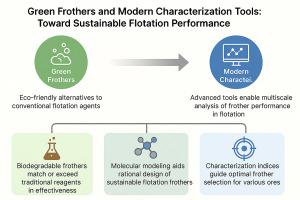Green frothers and modern characterization tools: Toward sustainable flotation performance
IF 7.1
Q1 ENGINEERING, CHEMICAL
引用次数: 0
Abstract
Flotation remains the most widely used method for recovering valuable minerals, particularly sulfide ores and certain non-sulfide ores such as oxides and phosphates. However, its environmental impact driven by high energy consumption, substantial water usage, and dependence on petrochemical-based reagents presents increasing sustainability challenges. In recent years, green frothers produced from renewable resources or industrial waste, including rhamnolipids, sophorolipids, plant-derived glycosides, polymer–surfactant blends, and esters, have emerged as sustainable alternatives. These frothers exhibit improved foamability, froth stability, controlled bubble size distribution, and enhanced flotation selectivity compared to conventional reagents. Advanced characterization indices, such as critical micelle concentration (CMC), froth stability index, Sauter mean bubble diameter (SMD), gas holdup, and water recovery index, are highlighted to quantify frother behavior and flotation efficiency. Computational approaches, including molecular dynamics simulations and density functional theory (DFT), provide predictive insights for rational design and performance optimization of next-generation frothers. Furthermore, challenges such as variability in water quality, cost, and industrial scalability are considered, and future research directions are proposed to accelerate the transition toward environmentally sustainable and efficient flotation practices. By integrating experimental, computational, and environmental assessment methods, this manuscript aims to provide a comprehensive framework for the development and application of green frothers in mineral processing. The novelty of this article lies in its holistic framework that connects green frother chemistry, advanced characterization metrics (e.g., CMC, SMD, water recovery index), and computational tools, thereby bridging the gap between environmental sustainability and flotation performance.

绿色起泡剂和现代表征工具:走向可持续浮选性能
浮选仍然是回收有价值矿物的最广泛使用的方法,特别是硫化物矿石和某些非硫化物矿石,如氧化物和磷酸盐。然而,由于高能耗、大量用水和对石化试剂的依赖,其对环境的影响带来了越来越多的可持续性挑战。近年来,从可再生资源或工业废料中生产的绿色起泡剂,包括鼠李糖脂、槐油脂、植物源糖苷、聚合物表面活性剂混合物和酯类,已经成为可持续的替代品。与传统试剂相比,这些起泡剂表现出更好的起泡性、泡沫稳定性、控制气泡大小分布和增强的浮选选择性。先进的表征指标,如临界胶束浓度(CMC),泡沫稳定性指数,Sauter平均气泡直径(SMD),气含率和水回收指数,强调量化起泡行为和浮选效率。计算方法,包括分子动力学模拟和密度泛函理论(DFT),为下一代起泡剂的合理设计和性能优化提供了预测性见解。此外,还考虑了水质变化、成本和工业可扩展性等挑战,并提出了未来的研究方向,以加速向环境可持续和高效的浮选实践过渡。通过整合实验、计算和环境评价方法,本文旨在为绿色起泡剂在矿物加工中的开发和应用提供一个全面的框架。本文的新颖之处在于其整体框架将绿色泡沫化学、先进的表征指标(如CMC、SMD、水回收指数)和计算工具联系起来,从而弥合了环境可持续性和浮选性能之间的差距。
本文章由计算机程序翻译,如有差异,请以英文原文为准。
求助全文
约1分钟内获得全文
求助全文
来源期刊

Chemical Engineering Journal Advances
Engineering-Industrial and Manufacturing Engineering
CiteScore
8.30
自引率
0.00%
发文量
213
审稿时长
26 days
 求助内容:
求助内容: 应助结果提醒方式:
应助结果提醒方式:


